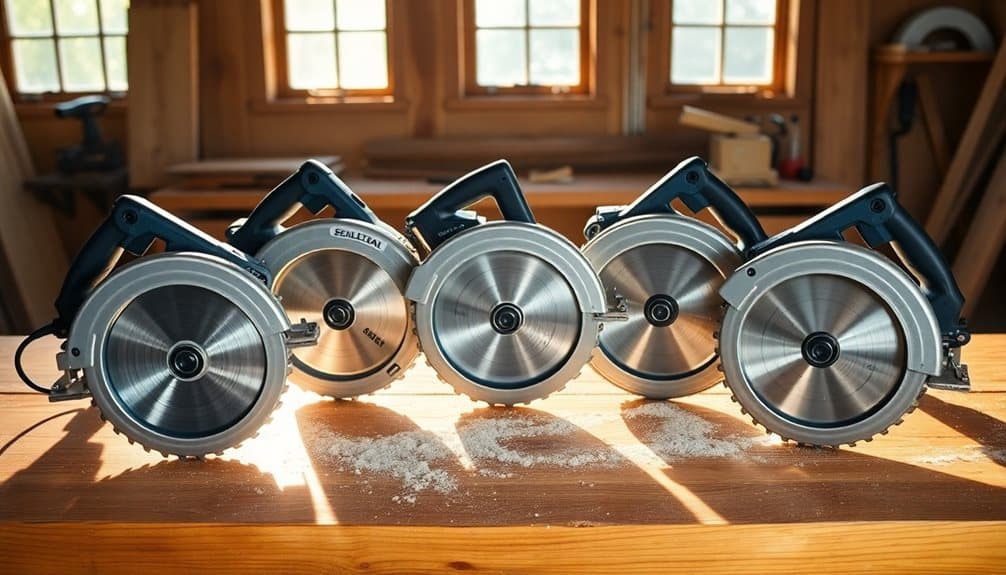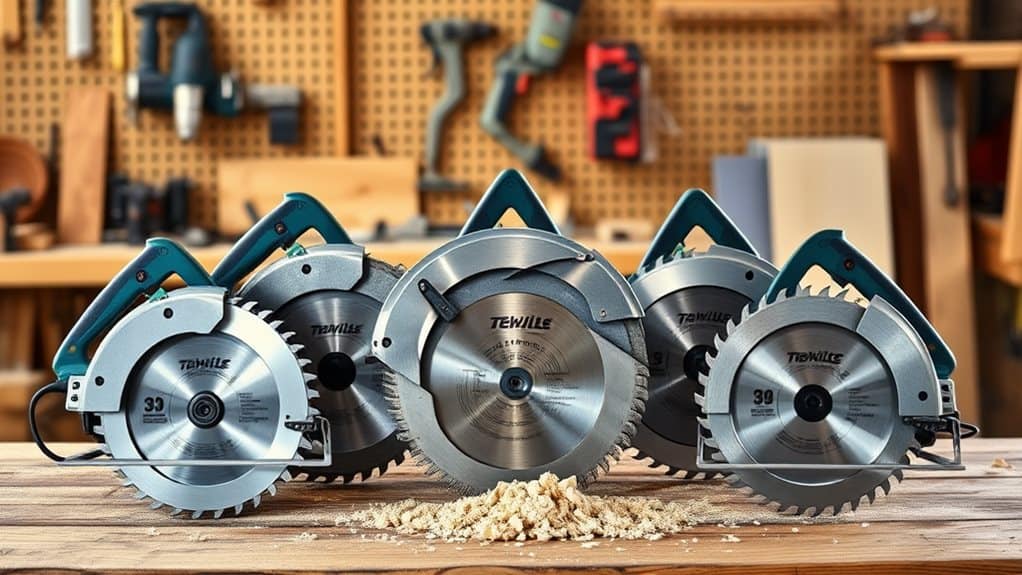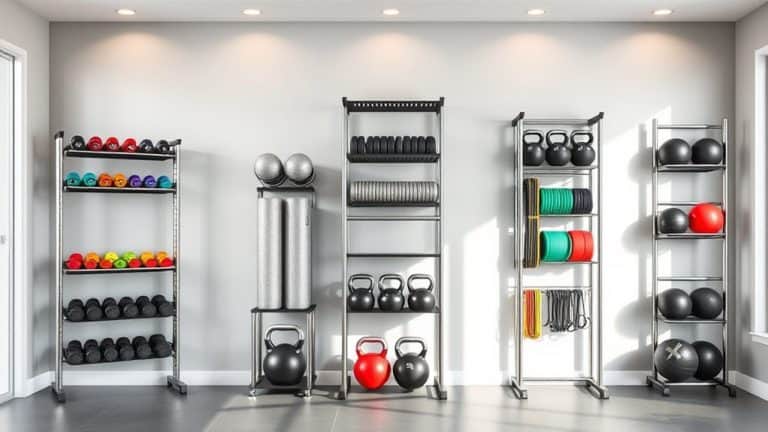This website contains affiliate links. Some products are gifted by the brand to test. As an Amazon Associate, I earn from qualifying purchases. The content on this website was created with the help of AI.
The top circular saws of 2024 combine power, precision, and user-friendly features to meet your woodworking needs. You’ll find the Skil 5080-01 offers excellent value with its lightweight design and 13-amp motor, while the DEWALT DCS391B delivers cordless convenience with its 20V system. The SKIL 5280-01 stands out for its laser guide and robust 15-amp motor, and the DEWALT DWE575SB impresses with its electric brake and versatile bevel capacity. The BOSCH CS10 rounds out the list with premium build quality and smooth cutting performance. Exploring each saw’s unique capabilities will help you make the perfect choice for your projects.
Key Takeaways
- DEWALT DWE575SB leads as the top choice with its 15-amp motor, electric brake, and exceptional 57-degree bevel capacity for professional needs.
- SKIL 15 Amp 5280-01 offers excellent value with laser guidance, robust motor, and comprehensive safety features for both DIY and professional use.
- DEWALT 20V MAX DCS391B provides superior portability with its cordless design and powerful 5150 RPM motor for versatile cutting applications.
- BOSCH CS10 delivers professional-grade performance with its durable magnesium construction and precise 56-degree bevel capacity for detailed work.
- SKIL 5080-01 stands out for its lightweight design and dust management system, making it ideal for extended use and clean cuts.
Skil 5080-01 13-Amp 7-1/4 Circular Saw, Red
- 13 Amp motor for more power and performance than the SKIL 5380
- 15% weight reduction vs. SKIL 5380, reduces user fatigue
- 51-Degree bevel with positive stops for great cut capacity
DIY enthusiasts and homeowners will find the Skil 5080-01 a perfect entry-level circular saw, thanks to its 13-amp motor and lightweight design that’s 15% lighter than its predecessor. You’ll appreciate its versatility with a bevel capacity up to 51 degrees and a positive stop at 45 degrees for precise angle cuts.
The saw comes equipped with an 18-tooth carbide blade and features a spindle lock for quick blade changes. While you’ll need to wear hearing protection due to noise levels, the built-in dust blower helps keep your cutting line visible. The saw excels at basic tasks like cutting shelving and mitering trim, making it ideal for home workshops and DIY projects. Though it has some plastic components, users consistently praise its smooth cuts and accurate performance. Just remember to use proper safety gear, including safety glasses and gloves, during operation.
Best For: DIY enthusiasts and homeowners seeking an affordable, lightweight circular saw for basic woodworking projects and home improvements.
Pros:
- Lightweight design (15% lighter than previous model) reduces user fatigue
- Versatile bevel capacity up to 51 degrees with positive stop at 45 degrees
- Built-in dust blower and spindle lock for improved usability and visibility
Cons:
- High noise levels require hearing protection
- Plastic components may affect long-term durability
- Limited dust collection capabilities leads to messy operation
DEWALT 20V MAX Circular Saw (DCS391B)
- 5150 RPM motor of DEWALT circular saw delivers power and speed to make the most demanding cuts with ease
- High strength and lightweight magnesium shoe of the corded circular saw provides jobsite durability for long-term cut accuracy
- Optimized rubber overmolded comfort grip of the compact circular saw delivers optimal balance and control
Professional contractors and home renovators seeking a powerful cordless saw will find their match in the DEWALT 20V MAX Circular Saw (DCS391B). With a 5150 RPM motor and 6-1/2-inch blade, this lightweight powerhouse delivers impressive cutting performance while reducing user fatigue.
You’ll appreciate the saw’s 0-50 degree bevel capacity and magnesium shoe, which guarantee accurate cuts across various applications. The rubber overmolded grip provides excellent control, while the keyless blade change feature saves you time between tasks. Though the included blade isn’t exceptional, you can easily upgrade to a higher-quality option like the Vermont American 40T blade for superior results.
At just 6.95 pounds, this cordless saw ranks #1 in its category with a 4.7-star rating. For peak performance, pair it with DEWALT’s 4Ah or 5Ah batteries, and you’ll have enough power for most DIY projects and professional applications.
Best For: Professional contractors and serious DIY enthusiasts who need a powerful, portable circular saw for medium-duty cutting tasks and want the flexibility of a cordless tool.
Pros:
- Powerful 5150 RPM motor and lightweight design (6.95 lbs) provide excellent cutting performance while reducing user fatigue
- Versatile 0-50 degree bevel capacity and durable magnesium shoe ensure precise cuts in various applications
- High user ratings (4.7/5 stars) and compatibility with all DEWALT 20V Max batteries make it a reliable choice
Cons:
- Stock blade is subpar and may need immediate replacement for optimal performance
- Battery and charger not included, adding to initial cost
- Battery life can be limited with smaller capacity batteries, requiring investment in 4Ah or 5Ah batteries for extended use
SKIL 15 Amp 7-1/4 Inch Circular Saw with Single Beam Laser Guide – 5280-01
- Powerful 15-amp motor delivers 5 300-RPM for greater speed and faster cuts
- 7-1 4-inch carbide-tipped blade included. Spindle lock for easy blade changes.
- 51° bevel capacity with a positive stop at 45° for a wide variety of cuts
For budget-conscious woodworkers who don’t want to sacrifice power, the SKIL 15 Amp 7-1/4 Inch Circular Saw (5280-01) delivers impressive performance at an accessible price point. You’ll get a robust 15-amp motor that spins at 5,300 RPM, effortlessly cutting through 2x4s and plywood like butter.
The saw’s single beam laser guide helps you achieve precise cuts, while the integrated dust blower keeps your cutting line visible. You’ll appreciate the 51° bevel capacity with a positive stop at 45° for angled cuts. Safety features include a guarded trigger and power-on indicator to prevent accidental starts. While the bed plate might feel slightly flimsy for precision work, and you may need to calibrate the angles, you’ll find this saw offers exceptional value for both DIY projects and heavy-duty tasks. The included carry bag makes transport convenient.
Best For: DIY enthusiasts and homeowners seeking a powerful, budget-friendly circular saw that offers professional-grade features like laser guidance and substantial cutting power.
Pros:
- Powerful 15-amp motor with 5,300 RPM delivers exceptional cutting performance through various materials
- Helpful features like laser guide, dust blower, and safety lock enhance accuracy and user experience
- Excellent value for money with included carry bag and versatile 51° bevel capacity
Cons:
- Bed plate may feel somewhat flimsy for precision work
- May require initial angle calibration for maximum accuracy
- Base plate quality could be more robust for professional-grade precision work
DEWALT 7-1/4 inch Corded Circular Saw (DWE575SB)
- DEWALT 7 1/4 circular saw is among the lightest saws in its class (8.8 lbs.)
- Electric brake of the corded circular saw stops the blade after trigger is released
- 15 amp motor of the compact circular saw delivers power for even the toughest applications
Weighing in at just 8.8 pounds, the DEWALT DWE575SB circular saw strikes an impressive balance between power and portability. Its 15-amp motor tackles tough cuts with ease, while the electric brake quickly stops the blade for enhanced safety. You’ll appreciate the saw’s versatile 57-degree bevel capacity with convenient stops at 45 and 22.5 degrees.
The durable aluminum base guarantees accurate cuts, and you’ll find the blade adjustments smooth and precise. While the included 24-tooth blade is serviceable, you might want to upgrade it for peak performance. The saw excels at cutting various materials, from 2x4s to plywood, with a generous 2-9/16-inch depth capacity. Professional users particularly praise its reduced noise level and effective dust-blowing feature. The included tote bag makes transportation convenient, though some prefer a hard case for better protection.
Best For: Professional contractors, home renovators, and DIY enthusiasts seeking a lightweight yet powerful circular saw for precise cuts across various materials.
Pros:
- Exceptionally lightweight at 8.8 lbs with excellent balance and ergonomics for reduced fatigue
- Powerful 15-amp motor with electric brake for quick blade stops and enhanced safety
- Versatile 57-degree bevel capacity with convenient preset stops at common angles
Cons:
- Stock blade may need replacement for optimal performance
- Comes with a soft tote bag instead of a more protective hard case
- No safety lock on the power switch
BOSCH CS10 15 Amp Circular Saw
- ROBUST CIRCULAR SAW DESIGN: Features a 15 Amp motor for cuts up to 2-7/16 In. at 90°, and is only 10.2 Lbs. in weight
- DIE-CAST MAGNESIUM FOOTPLATE: For unmatched durabiltiy and flatness
- SAW HOOK: Convenient saw storage between cuts
Equipped with a robust 15-amp motor and magnesium components, the Bosch CS10 circular saw strikes an excellent balance between power and durability for DIY enthusiasts and weekend warriors. You’ll appreciate its die-cast magnesium footplate and upper guard, which provide strength while keeping the weight at a manageable 10.3 pounds.
The saw delivers impressive cutting capacity, handling depths up to 2-7/16 inches at 90 degrees, with convenient positive detents at 22.5 and 45 degrees. You’ll find the bevel capacity extends to 56 degrees, offering versatility for various cutting angles. The tool’s optimized sight lines and Bosch-exclusive bevel louvers help you make precise cuts while managing dust effectively.
With a 4.6-star rating from nearly 1,000 users, this saw’s performance speaks for itself, though some users note the plastic components might not suit daily professional use.
Best For: DIY enthusiasts and weekend woodworkers seeking a powerful, reliable circular saw for occasional home projects and moderate carpentry tasks.
Pros:
- Powerful 15-amp motor and 4400 RPM deliver smooth, efficient cuts through various materials
- Lightweight magnesium components provide durability while maintaining manageable weight
- Excellent bevel capacity (up to 56 degrees) with convenient positive detents at common angles
Cons:
- Plastic components may not hold up well under heavy, daily professional use
- Relatively heavy at 10.3 pounds compared to some competitors
- Higher price point than basic consumer-grade circular saws
Factors to Consider When Choosing Circular Saws

When you’re in the market for a circular saw, you’ll need to evaluate several key factors that impact performance and usability. These essential elements include the saw’s power rating and motor type, overall weight and ergonomic design, blade specifications and quality, built-in safety mechanisms, and maximum cutting depth capacity. Your choice should align with your specific needs, whether you’re a DIY enthusiast or professional contractor, as each factor directly influences the saw’s effectiveness and your working experience.
Power and Motor Type
Power stands as an essential factor when selecting a circular saw, with most corded models featuring 13 to 15-amp motors that deliver reliable cutting performance. When you’re evaluating a saw’s power, you’ll want to take into account both the motor rating and the RPM. Higher RPM ratings, such as 5,300 or 5,150, will give you faster, cleaner cuts through your materials.
If you’re thinking about a cordless model, look for ones with 20-volt lithium-ion batteries. While these won’t match the continuous power of corded models, they’ll provide enough strength for most cutting tasks while offering the convenience of portability. You’ll also need to decide between brushed and brushless motors. Brushless motors are the more advanced option – they’re more efficient, require less maintenance, and typically last longer than their brushed counterparts.
Don’t forget to factor in the motor’s weight when making your choice. A lighter motor will help reduce fatigue during long projects, especially if you’ll be making numerous cuts. This becomes particularly important if you’re working on larger job sites or handling extended cutting sessions.
Weight and Ergonomic Design
The weight and ergonomic features of a circular saw directly impact your cutting performance and comfort level throughout the workday. When you’re working on extended projects, a lighter saw like the DEWALT DCS391B, weighing just 6.95 pounds, will help prevent fatigue and maintain your cutting accuracy over time.
You’ll want to pay close attention to how the saw feels in your hands. Look for models with rubber overmolded grips, which provide better control and reduce strain on your hands and wrists during operation. A well-balanced saw is equally important – it should distribute weight evenly across the tool, helping you maintain stability and follow cutting lines with precision.
Consider saws that incorporate lightweight materials, such as magnesium shoes, which enhance performance while keeping the overall weight down. This design choice doesn’t compromise durability but makes a significant difference in maneuverability. When you’re working in tight spaces or making numerous cuts, you’ll appreciate a saw that’s both light and easy to handle. The right combination of weight and ergonomic features will improve your efficiency and help you achieve more accurate results in your woodworking projects.
Blade Size and Quality
Beyond the physical handling of your circular saw, selecting the right blade forms the foundation of cutting performance. You’ll find that most circular saws come equipped with a standard 7-1/4 inch blade, which provides ample cutting depth for typical construction materials like lumber and plywood.
When evaluating blade quality, you’ll want to focus on carbide-tipped options. These blades maintain their edge considerably longer than standard steel versions, making them a worthwhile investment for regular use. The blade’s tooth count is another vital factor—if you’re doing rough framing work, choose a blade with fewer teeth for faster cuts. For finish work and cabinetry, opt for blades with higher tooth counts to achieve smoother edges.
Don’t overlook the blade’s kerf width. Thinner blades remove less material during cuts, which means your saw’s motor won’t have to work as hard. This results in more precise cuts and less strain on your tool. You’ll also need to match your blade type to your specific task—whether you’re framing, finishing, or working with specialty materials—to guarantee you’re getting peak performance from your circular saw.
Safety Features Available
Modern circular saws come equipped with essential safety mechanisms that protect you during operation and maintenance. One of the most important features you’ll find is the electric brake system, which rapidly stops the blade when you release the trigger, greatly reducing the risk of accidental contact with the spinning blade after your cut.
You’ll want to look for models with safety locks and guard triggers, as these prevent the saw from starting unexpectedly. When you’re making precise cuts, an integrated dust blower becomes invaluable by keeping your cutting line visible, helping you maintain accuracy and avoid dangerous mistakes. For blade changes, a spindle lock feature lets you safely and quickly swap blades without struggling with multiple tools.
Pay attention to the bevel and depth adjustment systems. The best models include positive stops at commonly used angles, which not only improve your cutting precision but also reduce the chance of dangerous misalignments. When you’re comparing different saws, make sure these safety features are present and easily accessible. They shouldn’t interfere with your workflow but should instead enhance both your protection and cutting efficiency.
Cutting Depth Capacity
Understanding cutting depth capacity stands as an essential factor in choosing your ideal circular saw. When you’re selecting a model, you’ll need to take into account the maximum depth it can cut at 90 degrees, which typically ranges from 2-1/8 inches to 2-9/16 inches for standard 7-1/4 inch blades.
You’ll want to match your saw’s cutting depth to your typical project needs. If you’re regularly working with thick materials like 2x4s or multiple layers of plywood, you’ll benefit from a saw with greater depth capacity. The blade diameter directly affects this capability – larger blades cut deeper but may make your saw less portable and harder to control.
Don’t overlook the importance of bevel capacity, which works in tandem with cutting depth. Most saws offer bevel angles up to 45 degrees, while some premium models extend to 56 degrees, giving you more versatility for angled cuts. You’ll also want to check the depth adjustment features, as they’re vital for making precise cuts. Look for smooth, reliable adjustment mechanisms that let you set and maintain exact cutting depths throughout your project.
Bevel Adjustment Range
The bevel adjustment range equips your circular saw with the versatility needed for complex angular cuts. When you’re shopping for a circular saw, you’ll want to look for models that offer a wide bevel capacity, ideally between 0 to 56 degrees. This range will give you the flexibility to tackle everything from standard crosscuts to more intricate miter and bevel cuts in your woodworking projects.
Pay attention to models that feature positive stops at common angles, particularly at 45 degrees. These preset stops aren’t just convenient—they’ll help you make accurate, consistent cuts without spending extra time on adjustments. You’ll also want to evaluate how easily you can adjust the bevel settings. The best circular saws offer smooth, user-friendly bevel adjustments that you can change quickly between cuts, keeping your workflow efficient.
If you’re planning on making aggressive angled cuts, look for saws with a bevel capacity of at least 51 degrees. This extended range will give you more options for specialized cuts and complex joinery. Remember, a wider bevel adjustment range directly impacts your saw’s versatility and your ability to complete diverse woodworking tasks with precision.
Frequently Asked Questions
How Long Do Circular Saw Blades Typically Last Before Needing Replacement?
You’ll need to replace your circular saw blade based on usage frequency and material type. With regular DIY use, a quality blade can last 12-120 hours of cutting time. If you’re cutting softwoods, expect longer life, while hardwoods and composites will dull blades faster. You’ll know it’s time to replace when you notice more tear-out, burning, or if you’re forcing the saw through cuts.
Can Circular Saws Be Used to Cut Through Metal Pipes?
Just as a hot knife slices through butter, you can cut through metal pipes with a circular saw – but you’ll need the right blade. While standard wood blades won’t work, you’ll want to use specialized metal-cutting blades made with carbide or diamond tips. You can cut through steel, copper, and aluminum pipes when you’re using the correct blade, proper speed settings, and safety gear like goggles and gloves.
What Safety Equipment Is Essential When Operating a Circular Saw?
When operating a circular saw, you’ll need several essential safety items. Always wear impact-resistant safety glasses to protect your eyes from flying debris. You should use ear protection to guard against loud noise and heavy-duty work gloves for hand safety. Don’t forget a dust mask to prevent inhaling sawdust. It’s also vital to wear close-toed shoes and avoid loose clothing that could get caught in the blade.
Is It Possible to Sharpen Circular Saw Blades at Home?
Like a skilled craftsman breathing new life into tired tools, you can sharpen circular saw blades at home with the right approach. You’ll need a diamond file, protective gear, and patience. Start by securing the blade firmly, then work methodically on each tooth, maintaining the original angle. However, if your blade’s carbide-tipped or severely damaged, it’s better to let a professional handle it, as improper sharpening can ruin the blade or create safety hazards.
What’s the Average Noise Level of Circular Saws During Operation?
You’ll typically experience noise levels between 85-95 decibels when operating a circular saw, which is quite loud and can be harmful to your hearing. That’s about as noisy as a motorcycle or lawn mower. You’ll definitely want to wear ear protection, as exposure to sounds above 85 decibels for extended periods can cause hearing damage. The noise level can vary depending on what you’re cutting and the saw’s power rating.









